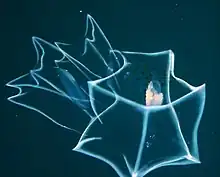| Bassia bassensis | |
|---|---|
 | |
| Scientific classification | |
| Domain: | Eukaryota |
| Kingdom: | Animalia |
| Phylum: | Cnidaria |
| Class: | Hydrozoa |
| Order: | Siphonophorae |
| Family: | Abylidae |
| Genus: | Bassia L. Agassiz, 1862[1] |
| Species: | B. bassensis |
| Binomial name | |
| Bassia bassensis | |
| Synonyms[3][4] | |
|
Genus synonymy
Species synonymy
| |
Bassia is a monotypic siphonophore genus in the family Abylidae. The genus contains the single species Bassia bassensis.[5]
Description
The species reaches body lengths of 6–8 cm. The body plan is radially symmetric around a central mouth, with a polyhedral shape bearing 4 main ridges which end in short basal teeth. The species is bioluminescent and has a bluish tint on the ridges of the nectophores and is covered in gelatinous sheets that form a "box" around the mouth.[6] As in all cnidarians, there is a single gastrovascular cavity (the coelenteron) and the mouth acts as both mouth and anus; it is surrounded by a layer of tentacles bearing nematocysts.[7]
Distribution
Bassia bassensis is common in warmer and tropical waters in the Atlantic and Pacific oceans, specifically around the African and Asian coasts.[8] It is common in the Humboldt Current system,[9] along with other gelatinous zooplankton off the coast of South America, where three currents mix together. The species is generally found in the top 50 meters of the epipelagic zone of the ocean.[10]
Ecology
The species primarily preys on copepods in the 0.4-1.2 mm size range.[10]
Populations can be among the most abundant species of siphonophores. Abundance may be impacted by small variations in salinity and temperature, leading to great increases at temperatures below 28 degrees Celsius, and dwindling in temperatures greater than 28.5 degrees.[11] Enough food availability in the concerned areas might mitigate the negative effect of low or high salinity waters, given the positive and significant relationship between siphonophore WDV and zooplankton wet weight biomass.[12]
References
- ↑ Agassiz, L. (1862). Contributions to the Natural History of the United States of America. Little Brown, Boston. 4: 1-380, pls 1-19., available online at http://www.biodiversitylibrary.org/item/54510#page/9/mode/1up Archived 2015-12-11 at the Wayback Machine page(s): 372
- ↑ Quoy, J. R. C. & Gaimard, J. P. (1833). "Zoologie IV: Zoophytes". In: Zoologie. Voyage de la corvette l'Astrolabe : exécuté par ordre du roi, pendant les années 1826-1827-1828-1829 / sous le commandement de J. Dumont d'Urville. pp. 1-390. Paris, J. Tastu., available online at http://www.biodiversitylibrary.org/item/18513#page/9/mode/1up Archived 2015-06-14 at the Wayback Machine page(s): 91, pl. 4 figs 18-20
- ↑ "Bassia". WoRMS. World Register of Marine Species. Retrieved 2 June 2022.
- ↑ "Bassia bassensis". WoRMS. World Register of Marine Species. Retrieved 2 June 2022.
- ↑ Herring, Peter J. (1987). "Systematic distribution of bioluminescence in living organisms". Journal of Bioluminescence and Chemiluminescence. 1 (3): 147–163. doi:10.1002/bio.1170010303. PMID 3503524.
- ↑ "Bassia bassensis - Zooplankton". www.imas.utas.edu.au. 2013-07-08. Retrieved 2022-04-24.
- ↑ "Cnidaria". biosurvey.ou.edu. Retrieved 2022-04-24.
- ↑ "WoRMS - World Register of Marine Species - Bassia bassensis (Quoy & Gaimard, 1833)". www.marinespecies.org. Retrieved 2022-04-24.
- ↑ Palma, S.; Silva, N. (2006-09-08). "Epipelagic siphonophore assemblages associated with water masses along a transect between Chile and Easter Island (eastern South Pacific Ocean)". Journal of Plankton Research. 28 (12): 1143–1151. doi:10.1093/plankt/fbl044. ISSN 0142-7873.
- 1 2 Pagès, F; González, HE; Ramón, M; Sobarzo, M; Gili, JM (2001). "Gelatinous zooplankton assemblages associated with water masses in the Humboldt Current System, and potential predatory impact by Bassia bassensis (Siphonophora: Calycophorae)". Marine Ecology Progress Series. 210: 13–24. Bibcode:2001MEPS..210...13P. doi:10.3354/meps210013. hdl:10261/184183. ISSN 0171-8630.
- ↑ Lo, Wen-Tseng; Yu, Shwu-Feng; Hsieh, Hung-Yen (2013-07-11). "Effects of summer mesoscale hydrographic features on epipelagic siphonophore assemblages in the surrounding waters of Taiwan, western North Pacific Ocean". Journal of Oceanography. 69 (5): 495–509. doi:10.1007/s10872-013-0188-2. ISSN 0916-8370. S2CID 129382805.
- ↑ Sanvicente-Añorve, Laura; Alba, Claudia; Alatorre, Miguel A.; Flores-Coto, César (2007-04-02). "Cross-shelf and vertical distribution of siphonophore assemblages under the influence of freshwater outflows in the southern Gulf of Mexico". Hydrobiologia. 586 (1): 69–78. doi:10.1007/s10750-006-0492-6. ISSN 0018-8158. S2CID 10008740.